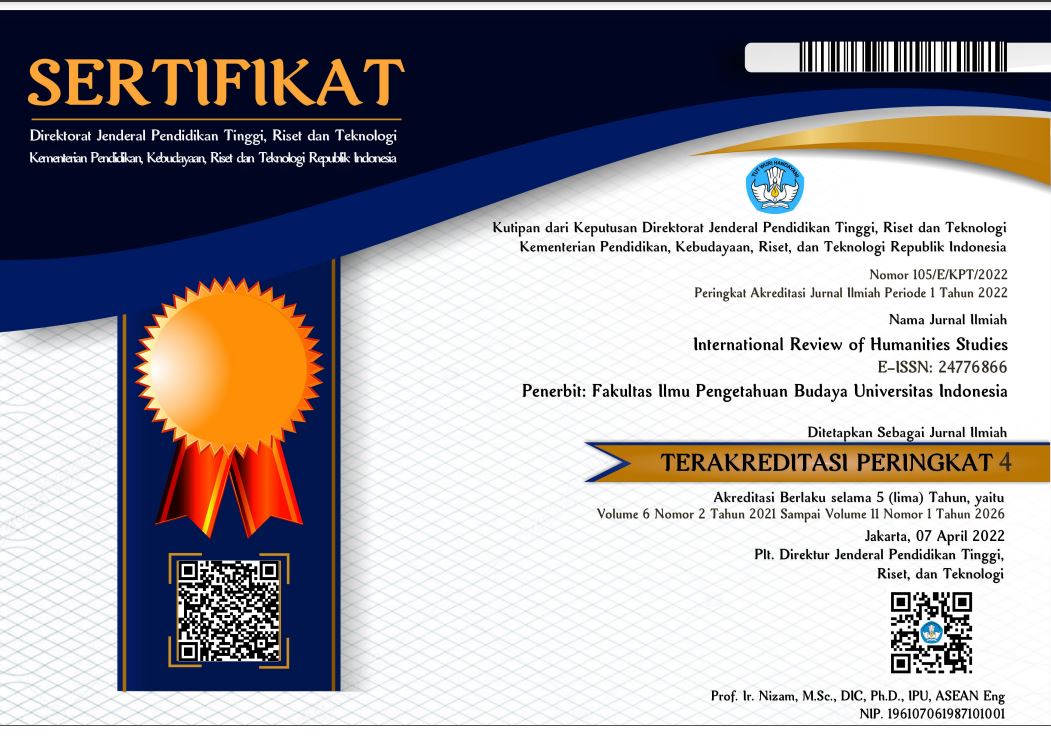International Review of Humanities Studies

Abstract
This article analyzes how public spaces—in the forms of two cafes and a tavern—are constructed as a third space in Elif Shafak's two novels, “The Bastard of Istanbul” (2008) and “The Island of Missing Trees” (2021). This research is a qualitative study with an approach in spatiality. The theory used in this study is the theory of Thirdspace by Edward Soja. The results of the study indicate that as the representation of the third space, the two cafes and a tavern in Shafak's two novels promote resistance to the conflicts and their impacts on the two conflicting groups, as well as constructed as sites that unite the groups. In “The Bastard of Istanbul”, the communication and relationships between the characters in Café Kundera and Café Constantinopolis show resistance to issues related to the 1915 Armenian genocide that gives impacts on the Turkish and Armenian relationship. Moreover, in “The Island of Missing Trees”, the characters’ friendship and intimacy at The Happy Fig Tavern show opposition to the ongoing internal conflict between Greek Cypriots and Turkish Cypriots which causes ethnic and territorial separation. A further examination of the third space reveals two different ways in how Shafak presents public spaces in both novels, specifically in terms of the visitors’ portrayal and the two distinct eras in which these public spaces are set. The outcomes of these two differences show that: (1) "The Bastard of Istanbul" is more political and explicit in its criticism of the Turkish government; and (2) "The Island of Missing Trees" focuses on the vulnerability of the third space during social conflicts, whereas "The Bastard of Istanbul" focuses on post-conflict recovery and reconciliation.
References
Akçam, T. (2004). From Empire to Republic. Turkish Nationalism and the Armenian Genocide. London, Zed Book.
Bal, M., & Van Boheemen, C. (2009). Narratology: Introduction to the theory of narrative. University of Toronto Press.
Borch, C. (2002). Interview with Edward W. Soja: Thirdspace, postmetropolis, and social theory. Distinktion: Scandinavian Journal of Social Theory, 3(1), 113-120.
Cooper, B., & Akçam, T. (2005). Turks, Armenians, and the "G-word". World Policy Journal, 22(3), 81-93.
Farrugia, D., & Wood, B. E. (2017). Youth and spatiality: Towards interdisciplinarity in youth studies. Young, 25(3), 209-218.
Furlanetto, E. (2014). “Safe Spaces of the Like-Minded”: The Search for a Hybrid Post-Ottoman Identity in Elif Shafak’s The Bastard of Istanbul. Commonwealth Essays and Studies, 36(36.2), 19-31.
Ghalia, B. (2022). A Quest for Third Space in Paul Bowles’s “By the Water” (1946), “The Scorpion” (1948) and “Tea on the Mountain” (1950). Language, 13(01), 429-457.
Henriksen, I. M. et al. (2013). The Café Community. In Tjora, A., & Scambler, G. (Eds.). Café Society. New York: Palgrave Macmillan.
Hill, F. et al. (2015). Armenia and Turkey: From normalization to reconciliation. Turkish Policy Quarterly, 13(4), 127-138.
Hua, A. (2005). Diaspora and Cultural Memory. In Agnew, V. (Ed.). Diaspora, memory and identity: a search for home. University of Toronto Press.
Iskandaryan, N. (2021). The Problem of Historical Memory in the Novel “The Bastard of Istanbul” by Elif Shafak. Вестник Российско-Армянского (Славянского) университета: гуманитарные и общественные науки, (1).
Liang, Y. (2020). The Spatial Imperative: The Need to Read Space in Salman Rushdie's Novels. Journal of Comparative Literature and Aesthetics, 43(3), 117-129. Chicago
Papadakis, Y. et al. (2006). Introduction: Modernity, History, and Conflict in Divided Cyprus: An Overview. In Papadakis, Y., Peristianis, N., & Welz, G. (Eds.). Divided Cyprus: Modernity, history, and an island in conflict. Indiana University Press.
Phillips, D. L. (2012). Diplomatic History: The Turkey-Armenia Protocols. Columbia University: Institute for the Study of Human Rights.
Schmid, C. (2008). Henry Lefebvre’s theory of the production of space: towards a three-dimensional dialectic. In Lefebvre, H., & Goonewardena, K. Space, difference, everyday life. New York.
Shafak, E. (2008). The Bastard of Istanbul. Penguin.
Shafak, E. (2021). The Island of Missing Trees. Penguin.
Soja, E. (2009). Toward a New Consciousness of Space and Spatiality. In Ikas, K., & Wagner, G. (Eds.). Communicating in the third space. Routledge.
Stenseth, B. (2013). Heart of Urbanism. The Café: A Chapter of Cultural History. In Tjora, A., & Scambler, G. (Eds.). Café Society. New York: Palgrave Macmillan.
Strolz, A. (2009). Spatial Practices, Representation of Space, and Spaces of Representation in Margaret Atwood’s Novels. In Eibl, D., & Rosenthal, C. (Eds.). Space and Gender: Spaces of Difference in Canadian Women's Writing/Espaces de différence dans l'écriture canadienne au féminin. Innsbruck University Press.
Tally Jr, R. T. (2020). Introduction: Spaces of the Text: Literary Studies After the Spatial Turn. In Tally Jr, R. T. (Ed.). Spatial Literary Studies: Interdisciplinary Approaches to Space, Geography, and the Imagination. Routledge.
Thacker, A. (2017). Critical literary geography. In Tally Jr, R. T. (Ed.). The Routledge handbook of literature and space. Taylor & Francis.
Warf, B. & Arias, S. (2009). Introduction: the reinsertion of space in the humanities and social sciences. In Warf, B., & Arias, S. (Eds.). The spatial turn: Interdisciplinary perspectives. Routledge.
Recommended Citation
Asyifa, Nurul Hanun and Zulyeno, Bastian
(2023)
"THE CONSTRUCTION OF THIRD SPACE IN ELIF SHAFAK’S TWO NOVELS,"
International Review of Humanities Studies: Vol. 8:
No.
1, Article 2.
DOI: 10.7454/irhs.v8i1.1001
Available at:
https://scholarhub.ui.ac.id/irhs/vol8/iss1/2


